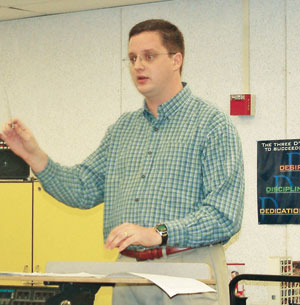For many bands, contest pieces are some of the hardest and most-rehearsed works of the year. Students who have a strong foundation of basic concepts taught throughout the year always have an easier time learning new music when its time to prepare for contest in the spring.
.jpg)
A Good Warm-Up
Most directors know that it takes a consistent effort to keep students engaged during the warm-up portion of a rehearsal or the effort becomes a mindless routine. In the past, I began rehearsals with regular exercises on long tones, lip slurs, and tuning; the only problem was that students did well for a few months while gaining a degree of proficiency and then progress stopped. Since abandoning the fundamentals was not an option, I developed several ways to maintain foreward momentum during the warm-up and keep the exercises fresh.
Start each day with a breathing exercise. I’ve always believed, perhaps naively, that students came to band knowing how to breathe and it was a waste to devote rehearsal time to breathing fundamentals. Then last year a clinician who worked with my ensemble suggested the benefits of a breathing exercise during the first part of a rehearsal. I committed to trying this practice for at least a week, and the benefits were immediately obvious.
The greatest change was that by taking time to work on breathing, students were calmer and more focused for the beginning of the rehearsal and throughout the warmup. By paying attention to taking a full, relaxed breath and not holding air in the body, many aspects of their playing also improved, including note starts and releases.
Vary the routine. It is easy to fall into the habit of repeating warm-ups daily, following the same order and in the same tempo. Certainly repetition is important, but it is helpful to vary the approach regularly. I have finally learned the lesson that it is not necessary to cover every warm-up daily. At some point the director has to trust students to hold onto a particular skill.
When I introduce a new exercise or skill, students repeat it for several consecutive days un-til they become proficient with it. Later I may alternate the ex-ercise with some-thing else. Some exercises I am reluctant to give up, but I try to do these only two or three times a week. I vary the overall warm-up daily so students do not become complacent.
Change the routine by extending an exercise. If the band has been working on Remington-type exercises, directors can extend the range, change the meter, or increase the tempo to keep things fresh. Adding more difficult rhythms and time signatures will enhance articulation drills. The idea is to keep exercises from become stale.
Add some humor. If it fits your teaching style and will not detract from rehearsal, a judicious use of humor can go a long way towards keeping drills from becoming boring.
A well-designed warm-up should include skills that relate to whatever music you are performing. This approach allows for ongoing refinement of the music even during daily drill.
Teaching in Advance
When programming music that will push students to a higher level of performance, I review the score, looking for specific skills and concepts they will need to perform piece well. Then we work on these elements apart from the music before I pass out the parts. This type of comprehensive approach helps students feel more at ease when work begins on the piece. Several difficult attributes in the music can benefit from work done in advance.
Time signature. If an ensemble is playing in a compound or mixed meter for the first time, spend as much time as necessary working on exercises with that time signature.
This spring one of my band’s contest pieces was Undertow by John Mackey. The time signature alternates between 44 and 78 for much of the piece so two weeks prior to passing out the music, my teaching focused on the pulse and foot tap (such as using down-press-up on the long beat) and counting rhythms in 78. The rhythms in Undertow became the guide I used in designing the exercises.
Rhythm. Students should be exposed to all the rhythms in a piece before working on the music. I often couple rhythm work with new time signatures. At first the students follow a rhythm sheet, playing unison rhythms on a common pitch, usually concert F. With more advanced rhythms, they may play unison melodic lines, often based on the music we are about to begin.
Articulation. There are a number of factors to consider when dealing with articulation, including speed of articulation necessary for a particular passage, styles called for in a particular piece, and the ability to maintain style over extended passages. Undertow has many long passages of eighth notes that students play, usually with their articulation becoming weaker as they move through the piece. By working on this skill during warm-ups and emphasizing the idea of tonguing firmly through out a passage, students develop an ability to play lengthy passages of eighth notes using a consistent articulation before they ever see the music.
Another important area is producing articulation that matches the style of music. Middle school students sometimes have difficulty maintaining the style in a lengthy work, particularly if the style is lifted, light, or marcato. Some pieces shift styles frequently within the same passage. I have adapted exercises from various method books that give students sufficient practice with different styles during the warm-up.
Range. When selecting music for middle school bands, directors have to evaluate whether their students can produce characteristic, resonant sounds in all ranges of a piece. This is particularly true with brass parts in music at grade three and above. Many of us have learned the hard way that it is difficult to use music to teach range. Students should have some proficiency in the range of a piece before starting it, or at least have a firm concept of tone production and playing certain high notes so that reaching for them does not lead to bad playing habits and tension in the body and the sound.
Range development continues all through the school year. By altering and extending lip slurs in class and using the air flow studies similar to those developed by Vincent Cichowicz, players extend their range over time. It is important to emphasize that high notes should be resonant and match the tone color of the lower notes on the instrument. When working on lip slurs, flow studies, or other exercises to extend range, it is helpful to use the alto saxophones as a model for the rest of the band where these skills are relatively to produce with good tone and a smooth line.
The lower range can also present problems for young players. I tell brass students to imagine blowing a wider column of air when playing low notes so the sound does not become harsh. The clarinet section can provide a wonderful example for the rest of the band when working to extend range downward. The nature of the clarinet allows for smooth and consistent response in the low register, making it easy for clarinet players to match the quality of their low notes to those in the middle part of their range, which is the goal for all instrumentalists.
Key and technique. Regardless of the difficulty of the music, the band has to be able to play comfortably in the key of a piece to the point that fingering critical notes does not take up an inordinate amount of time. Laying the foundation through playing scales and tetrachords can help eliminate problems with key signatures. Sightreading easier pieces in the same key will reduce problems later.
If a piece has certain technical difficulties, it may be helpful to write extended technical passages out for the entire band and work on them in unison. This helps students who may have these passages – many are usually in the flute and clarinet sections – and it can be fun for such instruments as the low reeds, trombone, and tuba whose parts are not always difficult.





